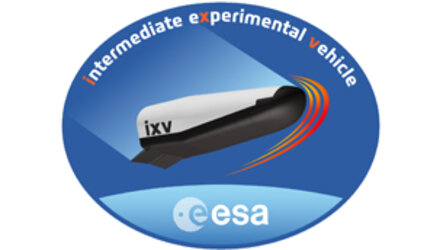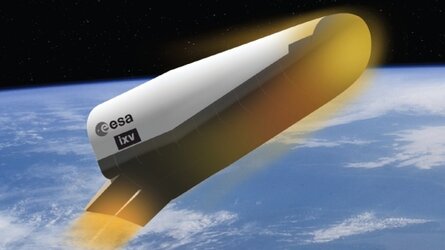IXV mission timeline
An annotated timeline of the most critical events during the IXV mission. ESA’s wingless spaceplane is set for liftoff on a Vega rocket from Kourou, French Guiana, 11 February 2015.
ESA’s Intermediate eXperimental Vehicle (IXV) will be launched on Vega flight VV04 at 13:00 GMT (14:00 CET) for a suborbital flight to test technologies and critical systems for Europe’s future automated reentry systems.
After separation from Vega at about 340 km altitude 18 minutes into flight, it will coast up to a maximum height of 412 km. Next, it will begin reentry, recording data from a large number of conventional and advanced sensors.
The entry speed of 27 000 km/h (7.5 km/s) creates the same conditions as those for a vehicle returning from low orbit. It will navigate through the atmosphere within its reentry corridor before descending, slowed by a multistage parachute, for a safe splashdown in the Pacific Ocean some 100 minutes after liftoff.

The spacecraft will fly fully autonomously, and will be closely monitored from its Mission Control Centre located at the Advanced Logistics Technology Engineering Centre in Turin, Italy. Signals from the spacecraft will be tracked by two ground stations in Africa and by an antenna on the recovery ship, Nos Aries.
On 11 February, follow the mission live starting 12:30 GMT (13:30 CET) via Arianespace TV and ESA TV.
IXV timeline
Times shown are pre- or post-launch elapsed times with respect to liftoff. All times are subject to change.
AOS: Acquisition of signal
BOT: Beginning of track
MCC: IXV Mission Control Centre at ALTEC, Turin
CSG: (Centre spatial guyanais), Vega mission control in Jupiter control room, Kourou
MAL: Ground tracking station, Malindi, Kenya
LIB: Ground tracking station, Libreville, Gabon
LOS: Loss of signal
TM: Telemetry
AVUM: Attitude Vernier Upper Module – Vega upper stage
| Time | Activity |
| –8h 15m | Start of IXV ground segment configuration, subsystem internal tests, activation of ground station links |
| –7h 45m | Start of Vega countdown |
| –7h 30m | Start of IXV data flow tests between MCC and ground stations |
| –6h 30m | Start of IXV ground segment-wide verification |
| –6h 15m | Voice check CSG-MCC-ship |
| –4h 45m | End of Mission Simulation No 1 |
| –3h 30m | Start of IXV countdown |
| –2h 40m | Mobile gantry withdrawal (45 min) |
| –2h 00m | Receive result of high-altitude wind measurement from ship meteo station (launched at L–4h) |
| –1h 00m | Ground segment configured for launch |
| –0h 34m | Launcher system ready |
| –0h 10m | Final launcher weather report |
| –0h 04m | Start Vega automated launch sequence |
| –0h 01m | IXV: switch to launch mode |
| H0 (14:00 CET) | Liftoff |
| +1m 52s | Separation of first stage (P80) |
| +3m 35s | Separation of second stage (Zefiro-23) |
| +4m 02s | Jettisoning of fairing (Vega now in space) |
| +6m 37s | Separation of third stage (Zefiro-9) |
| +8m 00s | AVUM first burn |
| +13m 49s | AVUM shutdown |
| +16m 13s | Libreville AOS Vega (earliest possible) |
| +17m 59s | Separation; IXV in free flight (earliest possible; window until 21m 34s) |
| +18m 20s | Libreville AOS IXV |
| During Libreville until after Malindi LOS | MCC receives IXV TM; IXV status continuously monitored; updates to predicted splashdown coordinates |
| +20m 34s | IXV: Reaction control system (thrusters) primed |
| Times below are estimates only and will depend on actual IXV progress | |
| +23m 30s | Malindi AOS |
| +25m 35s | Libreville LOS |
| +34m 12s | Malindi LOS |
| +1h 20m | BOT ship tracking antenna; ship now listening for IXV signals at end of reentry blackout |
| +1h 22m | End of reentry blackout; expected AOS ship tracking antenna; start receiving spacecraft TM & experimental data |
| +1h 25m | Parachute panel ejection |
| +1h 29m | Main parachute ejection |
| +1h 31m | IXV passivation |
| +1h 42m | Splashdown (forecast) |
| +1h 42m | After splashdown: MCC reports summary of IXV status, actual splashdown coordinates |
| Ship conducts recovery operations | |















 Germany
Germany
 Austria
Austria
 Belgium
Belgium
 Denmark
Denmark
 Spain
Spain
 Estonia
Estonia
 Finland
Finland
 France
France
 Greece
Greece
 Hungary
Hungary
 Ireland
Ireland
 Italy
Italy
 Luxembourg
Luxembourg
 Norway
Norway
 The Netherlands
The Netherlands
 Poland
Poland
 Portugal
Portugal
 Czechia
Czechia
 Romania
Romania
 United Kingdom
United Kingdom
 Slovenia
Slovenia
 Sweden
Sweden
 Switzerland
Switzerland



























